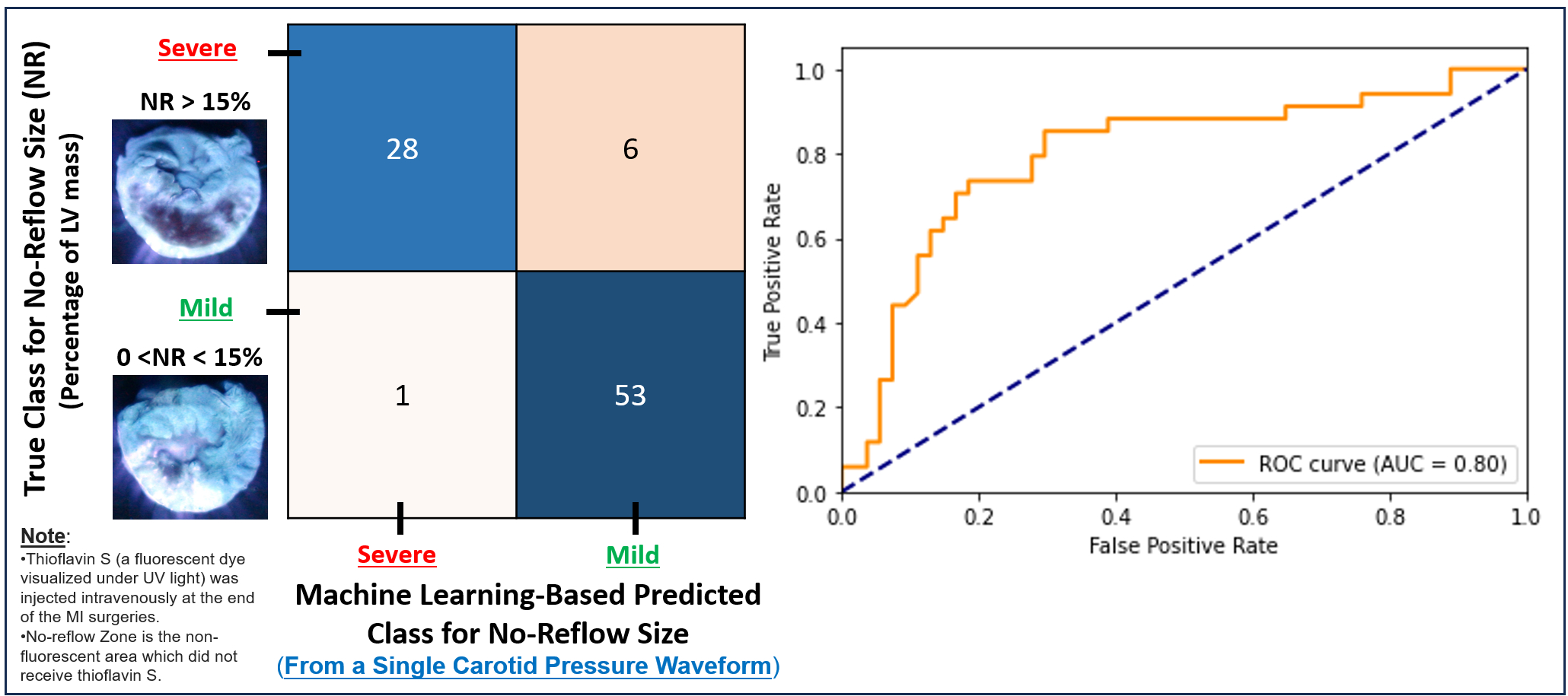Final ID: MDP1703
Instantaneous Classification of Myocardial No-Reflow Size from a Carotid Pressure Waveform: A Physics-Based Machine Learning Approach
Abstract Body (Do not enter title and authors here): Introduction: It was recently shown that the Intrinsic Frequency (IF) method, a systems approach for evaluating cardiovascular dynamics, combined with machine learning (ML) algorithms, instantaneously detects acute myocardial infarction (MI) or ischemia in rats (Alavi et al., European Heart Journal Open, 2023, PMID:37849787). Here, we aim to classify myocardial no-reflow size (NR) from carotid pressure waveforms using a hybrid physics-based ML approach.
Methods: We used the standard occlusion/reperfusion MI rat model (Sprague Dawley; Female; n=88) and induced necrosis via a 30-minute proximal left coronary artery occlusion followed by 3 hours of reperfusion. IFs were computed from carotid pressure waveforms measured 2 hours post-reperfusion. NR sizes (i.e., mass percentage of no-reflow over total left ventricle (LV)) were determined via histopathology (visualized by non-fluorescent area which did not receive thioflavin-S, Fig.1), ranging from NR=0.8% to 38.8%. NR=15% was used as the classification cut-off for mild and severe NR size classes. A support vector machine (SVC) model was developed using IFs and diastolic pressure of n=66 rats. K-fold cross-validation (k=5) was used to prevent overfitting. Finally, the model was blindly tested on n=22 additional rats.
Results: Our ML classifier model showed overall accuracy of 92% for all data when predicting the true class of NR, i.e., severe or mild (Fig.1). The model also showed a high accuracy of 73% using blind test rats.
Conclusions: Our results suggest that a hybrid IF-based ML approach can determine the severity of no-reflow zone using a single arterial pressure waveform, independent of advanced imaging techniques. The no-reflow phenomenon is clinically significant (distinct from infarct size) as it is linked to LV microvascular damage, LV remodeling, and thus patient recovery after reperfusion. Since IFs can be measured remotely and noninvasively e.g., via smartphones or wearables, our approach has significant potential for instantaneous pre-hospital identification of patients at risk for outcomes post-MI (e.g., heart failure or mortality).
Methods: We used the standard occlusion/reperfusion MI rat model (Sprague Dawley; Female; n=88) and induced necrosis via a 30-minute proximal left coronary artery occlusion followed by 3 hours of reperfusion. IFs were computed from carotid pressure waveforms measured 2 hours post-reperfusion. NR sizes (i.e., mass percentage of no-reflow over total left ventricle (LV)) were determined via histopathology (visualized by non-fluorescent area which did not receive thioflavin-S, Fig.1), ranging from NR=0.8% to 38.8%. NR=15% was used as the classification cut-off for mild and severe NR size classes. A support vector machine (SVC) model was developed using IFs and diastolic pressure of n=66 rats. K-fold cross-validation (k=5) was used to prevent overfitting. Finally, the model was blindly tested on n=22 additional rats.
Results: Our ML classifier model showed overall accuracy of 92% for all data when predicting the true class of NR, i.e., severe or mild (Fig.1). The model also showed a high accuracy of 73% using blind test rats.
Conclusions: Our results suggest that a hybrid IF-based ML approach can determine the severity of no-reflow zone using a single arterial pressure waveform, independent of advanced imaging techniques. The no-reflow phenomenon is clinically significant (distinct from infarct size) as it is linked to LV microvascular damage, LV remodeling, and thus patient recovery after reperfusion. Since IFs can be measured remotely and noninvasively e.g., via smartphones or wearables, our approach has significant potential for instantaneous pre-hospital identification of patients at risk for outcomes post-MI (e.g., heart failure or mortality).
More abstracts on this topic:
A Machine Learning Algorithm to Detect Pediatric Supraventricular Tachycardia Risk from Baseline ECGs
Arezoumand Amirhossein, Danala Gopichandh, Masnadi Khiabani Parisa, Ebert David, Behere Shashank
A Novel Classification of Heart Failure Derived from the Nationwide JROADHF Cohort Using Unsupervised Machine LearningKyodo Atsushi, Tsutsui Hiroyuki, Hikoso Shungo, Nakada Yasuki, Nogi Kazutaka, Ishihara Satomi, Ueda Tomoya, Tohyama Takeshi, Enzan Nobuyuki, Matsushima Shouji, Ide Tomomi

